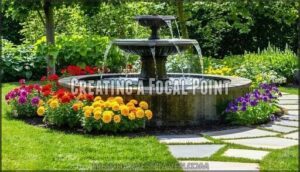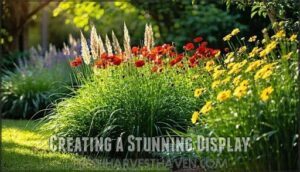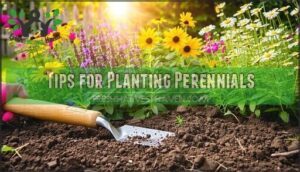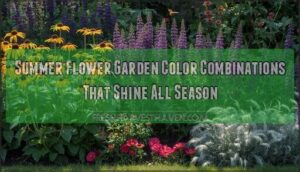This site is supported by our readers. We may earn a commission, at no cost to you, if you purchase through links.

You’ll create stunning displays using drought-tolerant plants like Russian sage, yarrow, and ornamental grasses that actually thrive in scorching temperatures.
Smart container arrangements let you move plants as needed, while strategic shade structures provide cool retreats.
Focus on water-wise perennials that bloom through summer’s peak, creating layers of texture and color that require minimal maintenance.
The secret lies in working with your climate’s natural rhythm, selecting plants that celebrate rather than merely survive summer’s intensity.
Discover how specific plant combinations and layout techniques can revolutionize your approach to hot-weather gardening.
Table Of Contents
- Key Takeaways
- Summer Garden Planning
- Drought Tolerant Gardens
- Summer Container Designs
- Celebrating Summer Light
- Refreshing Summer Gardens
- Frequently Asked Questions (FAQs)
- What is the 70/30 rule in gardening?
- How to plan a summer garden?
- What is the rule of 3 in gardening?
- What garden layout is best for sun?
- What are some summer garden ideas?
- How do you decorate a summer garden?
- What are the best summer landscaping ideas?
- How do you put on a summer show?
- What is a good garden design?
- How do you design a modern garden?
- Conclusion
Key Takeaways
- Choose drought-tolerant plants like Russian sage, yarrow, and ornamental grasses that thrive in heat rather than just survive it – you’ll create stunning displays with minimal water and maintenance requirements.
- Use strategic container arrangements to maximize flexibility in your space – you can move plants as needed, create focal points at different heights, and transform small areas into vibrant summer showcases.
- Plan your layout with microclimates in mind by evaluating sun patterns, soil conditions, and wind direction to match the right plants with ideal growing conditions for maximum success.
- Layer plants by height and texture while incorporating shade structures – you’ll create visual depth and cool retreats that make your garden both beautiful and functional throughout summer’s peak.
Summer Garden Planning
Planning your summer garden requires strategic decisions that will determine your outdoor space’s success throughout the warm season.
Start by evaluating your site’s sun patterns, soil conditions, and microclimates to match the right plants with ideal growing conditions, which is a crucial step in creating a thriving garden with complete concepts in mind.
The right plants in the right place transform your summer garden from surviving to absolutely thriving.
Choosing The Right Location
Location selection sets the foundation for your summer garden design success. Ideal placement requires careful analysis of multiple environmental factors that directly impact plant health and garden performance.
Key location assessment factors:
- Sun Exposure: Map 6-8 hours of direct sunlight for vegetables and flowers, noting shade patterns throughout the day
- Soil Analysis: Test drainage, pH levels (6.0-7.0 ideal), and organic matter content in potential sites
- Wind Direction: Identify prevailing winds and natural windbreaks to protect delicate plants from damage
Climate zones and terrain slope influence microclimates within your backyard oasis. South-facing areas warm faster, extending growing seasons, while low-lying spots may create frost pockets.
Position your garden within 30 feet of your home for convenient maintenance and frequent harvesting. Consider garden path ideas that provide easy access while protecting plants from foot traffic damage.
Deciding on a Theme or Style
Once you’ve secured the perfect spot, your garden’s personality starts taking shape through theme selection.
Garden themes provide the creative backbone for your backyard oasis, guiding color schemes and landscape design decisions.
Consider Mediterranean styles with drought-tolerant herbs, cottage gardens bursting with informal charm, or modern minimalist approaches featuring architectural plants.
Your chosen theme influences everything from outdoor decor ideas to garden decor accessories, creating cohesive summer garden design that reflects your personal style while working harmoniously with your space’s natural characteristics.
Selecting Plants and Flowers
Explore selecting plants and flowers by matching Flower Choices to your Garden Styles and color schemes.
Consider Blooming Times—mix perennials for long-lasting color and annuals for vibrant bursts.
Prioritize Plant Care; drought-tolerant varieties and native species thrive with less effort.
For small garden ideas, choose compact blooms. Blend textures for dynamic flower garden designs, enhancing your outdoor decor ideas and garden decor accessories.
Creating a Functional Layout
Once you’ve selected your plants, transform your outdoor spaces through strategic spatial planning that maximizes both beauty and function.
Create distinct functional zones by defining areas for entertaining, relaxation, and growing. Garden paths should guide visitors naturally through your layout design while connecting different sections.
Position garden furniture sets where they’ll get ideal use, considering sun patterns and privacy. Smart garden landscaping tips include placing taller plants as backdrops and shorter ones in front for visual depth.
Effective summer garden planning involves understanding summer vegetable layouts to optimize growth and aesthetics.
Tips for a Low Maintenance Garden
Your garden layout becomes more manageable when you choose drought-tolerant plants and implement smart soil care practices.
Select native species that thrive without constant attention, reducing your summer gardening workload.
Install drip irrigation systems and apply thick mulch for effective weed control.
Use quality garden tools for efficient maintenance tasks, and group plants with similar water needs together for streamlined backyard gardening tips success.
Drought Tolerant Gardens
Drought-tolerant gardens offer a smart solution for hot summer months when water conservation becomes essential.
You’ll create a beautiful, resilient landscape that thrives with minimal irrigation while reducing maintenance demands throughout the growing season.
Russian Sage and Yarrow
Throughout your drought-tolerant summer landscaping, Russian Sage and Yarrow deliver exceptional performance with minimal water requirements.
These hardy perennials thrive in poor soils while providing stunning visual impact.
Here are four essential considerations for incorporating these plants:
- Sage Varieties – Choose between Perovskia atriplicifolia for height or compact cultivars for borders
- Yarrow Colors – Select from yellow, pink, red, or white blooms to complement your garden design ideas
- Companion Plants – Pair with ornamental grasses and sedums for textural contrast
- Soil Preferences – Verify well-draining conditions; both plants tolerate poor, sandy soils excellently
Their Medicinal Uses historically include wound healing properties, making them both beautiful and functional additions to your summer garden design.
Black Cohosh and Bee Balm
Black cohosh thrives in partial shade, creating dramatic vertical accents in your summer garden design with its towering white flower spikes.
Bee balm varieties burst with vibrant colors, attracting pollinators while offering medicinal uses.
These companion plants complement each other perfectly – cohosh benefits include natural pest deterrence, while balm varieties provide continuous blooms.
Follow this planting guide for stunning summer outdoor spaces, utilizing the natural pest deterrence to enhance your garden.
Tips for Watering and Maintenance
Water your drought-tolerant plants deeply but less frequently to encourage strong root systems. Check soil moisture two inches down before watering – dry soil signals it’s time.
Apply 2-4 inch mulch layers around plants to retain moisture and reduce watering frequency by 30%.
Monitor for pests during summer seasons, as stressed plants attract insects.
Clean garden irrigation systems regularly and adjust watering frequency based on rainfall patterns.
Design Ideas and Inspiration
Nobody wants a drought-tolerant garden that looks like a desert wasteland.
Smart design transforms these resilient spaces into stunning summer retreats.
Consider these approaches:
- Color palettes using silver-leafed plants with purple blooms create sophisticated themed spaces
- Garden art and water feature designs add focal points between drought-resistant plantings
- Vertical gardens with cascading succulents maximize space while complementing patio furniture sets
Strategic garden lighting systems highlight textures after dark, proving water-wise doesn’t mean style-compromised.
Summer Container Designs
Container gardening transforms small spaces into vibrant summer showcases through strategic plant selection and creative vessel choices.
You’ll maximize visual impact by combining different heights, textures, and colors while ensuring proper drainage and plant compatibility.
Architectural Presence and Textures
Your container’s architectural presence transforms ordinary spaces into stunning outdoor sanctuaries.
Transform ordinary spaces into stunning sanctuaries with thoughtful container placement and design.
Structural Elements like tall ornamental grasses create dramatic Vertical Accents, while varied Texture Combinations add visual depth.
Garden Art pieces anchor compositions, and strategic Hardscape Materials provide foundation.
Summer decor flourishes when containers offer both function and beauty for your garden style inspiration.
| Container Element | Texture Effect |
|---|---|
| Corrugated metal planters | Creates industrial contrast |
| Natural stone vessels | Adds organic, weathered appeal |
| Sleek ceramic pots | Provides smooth, modern lines |
| Woven basket containers | Introduces rustic, tactile warmth |
Choosing The Right Plants
Your plant selection determines your container’s success throughout summer months. Choose native species that thrive in your local climate conditions, requiring less water and fertilizer than exotic alternatives.
Match soil compatibility with sunlight needs – full-sun summer flowers need six hours daily, while shade-tolerant varieties survive with less.
You can find various summer container plants for your garden. Consider watering requirements and bloom times for continuous color displays in your summer landscaping projects.
Creating a Focal Point
Transform your summer garden with strategic focal points that command attention and organize your space.
Bold colors from vibrant summer flowers create instant visual impact, while unique structures like garden art or sculpture placement add personality.
Water features introduce movement and sound, making your summer home feel like a resort.
To keep your container plants thriving, remember to address their drainage needs.
These yard decor inspiration elements anchor your summer landscaping design beautifully.
DIY Container Ideas
Budget-friendly creativity reveals endless possibilities for summer container gardening.
You’ll transform everyday items into stunning planters while saving money and expressing your unique style.
You can also find unique planter products to enhance your garden.
- Repurposed Containers: Old boots, colanders, and wooden crates create charming planters with proper drainage holes.
- Vertical Gardens: Stack tiered displays using pallet planters against walls for maximum growing space.
- Hanging Baskets: Suspend containers at varying heights to add dimension and showcase trailing plants effectively.
Celebrating Summer Light
Summer light transforms gardens into luminous displays that captivate throughout the growing season.
You’ll create magical spaces by strategically placing ornamental grasses and carefully selected mounding shrubs that catch and reflect sunlight at different angles, making the area a luminous display.
Incorporating Grasses and Mounding Shrubs
Ornamental grasses and mounding shrubbery create garden structure through texture contrast and visual interest.
You’ll achieve stunning results by pairing feathery grass plumes with dense, rounded shrubs. Consider fountain grass alongside boxwood or lavender for dramatic effect.
These combinations work beautifully in outdoor kitchen designs, requiring minimal maintenance while providing year-round appeal through varying heights and textures. Many thrive as sun loving plants, making them ideal for summer gardens with minimal maintenance.
Creating a Stunning Display
Strategic Color Combinations and Height Variation create your garden’s visual impact.
Position bold Focal Points using contrasting textures—pair fine ornamental grasses with broad-leaved perennials for maximum drama.
Layer plants at different heights, placing tall specimens behind shorter ones.
Incorporate Texture Contrast through silver foliage and deep greens.
Plan Seasonal Updates with succession plantings.
Use garden planning tools and landscaping design software to map your summer display, ensuring continuous color from June through August, and create a visual impact.
Tips for Planting Perennials
Successful perennial establishment requires proper timing and soil preparation during summer months.
Plant divisions when temperatures moderate in late summer, ensuring adequate root development before winter dormancy.
Consider these essential factors:
- Soil Preparation – Test pH levels and amend with organic matter
- Sunlight Needs – Match plant requirements to garden microclimates
- Watering Schedules – Establish consistent moisture without waterlogging
Deadheading techniques promote continued blooming throughout the growing season.
Perennial division every three to four years maintains plant vigor and prevents overcrowding in your backyard gardening space.
Combining With Other Plants
Three strategic companion planting approaches reveal your garden’s full potential.
Mix tall ornamental grasses with low-growing perennials for dramatic height variations.
Combine cool blues with warm yellows to achieve stunning color harmony.
Stagger bloom times so your summer display evolves continuously throughout the season.
| Plant Combination | Height Pattern | Color Scheme |
|---|---|---|
| Feather Reed Grass + Black-Eyed Susan | Tall backdrop with medium foreground | Golden yellows with green textures |
| Russian Sage + Catmint | Airy purple spikes over compact mounds | Cool purple and silver harmony |
| Ornamental Millet + Marigolds | Burgundy grass with bright annual accents | Warm contrast of red and orange |
This texture combination strategy transforms ordinary plantings into dynamic displays that celebrate summer light while supporting healthy plant growth through smart companion planting principles, creating a dramatic height variation and stunning color effects.
Refreshing Summer Gardens
Maintaining a thriving summer garden requires consistent attention to essential care practices that keep plants healthy during intense heat.
These fundamental maintenance tasks guarantee your garden stays refreshed and vibrant throughout the challenging summer months, which is crucial for a thriving summer garden to remain healthy.
Watering Tips and Chores
Efficient watering transforms summer garden maintenance from a chore into a manageable routine.
Water early morning to reduce evaporation and allow plants to absorb moisture before summer heat intensifies.
Check soil moisture regularly using your finger or sensors to establish proper watering schedules.
Drip irrigation systems and soaker hoses deliver water conservation benefits while maintaining consistent garden chores during challenging summer weather conditions.
Pruning and Trimming Plants
After keeping your plants hydrated, regular pruning techniques and trimming schedules become your garden’s secret weapon.
Deadheading flowers throughout summer extends blooming periods, while shaping hedges maintains clean lines.
Sharp, clean tools prevent disease spread – a simple wipe with rubbing alcohol works wonders.
Regular deadheading helps to extend bloom time.
These summer garden maintenance tips transform overgrown chaos into organized beauty, giving you complete control over your backyard gardening vision, by using techniques like deadheading and maintaining clean lines.
Mulching and Weeding
After trimming, weeds compete with your plants for nutrients and water.
Proper mulching prevents weed growth while retaining soil moisture.
Apply organic mulch at appropriate depths for effective weed prevention:
- Mulch Types: Use shredded bark, wood chips, or compost for natural weed suppression
- Mulch Depth: Maintain 2-3 inches around plants, avoiding stem contact
- Weeding Tools: Remove stubborn weeds with hand tools before mulching
Consider purchasing various mulch products to enhance your garden.
Fertilizing and Pest Control
Summer gardening success hinges on proper fertilizing and pest control strategies.
Organic fertilizers nourish your soil health while supporting beneficial insects that naturally combat summer pests. Apply slow-release nutrients early morning to prevent leaf burn.
Monitor summer crops regularly for pest identification—catching aphids or spider mites early saves your harvest. Integrated control methods combining cultural practices with targeted treatments keep your garden thriving without harsh chemicals, ensuring summer gardening success with proper fertilizing.
Frequently Asked Questions (FAQs)
What is the 70/30 rule in gardening?
Revolutionizing your garden layout starts with understanding the 70/30 rule.
Allocate seventy percent of your space to structural plants like shrubs and perennials, then thirty percent to seasonal color from annuals and accent plants, to create a balanced and visually appealing garden layout that adheres to the 70/30 rule.
How to plan a summer garden?
Start by choosing a sunny location with well-draining soil.
Plan your layout considering plant heights, spacing requirements, and bloom times.
Select heat-tolerant varieties that’ll thrive in summer’s intensity while ensuring adequate water access.
What is the rule of 3 in gardening?
Research shows 70% of successful gardens utilize repetition principles.
You’ll create visual harmony by grouping plants in odd numbers—three’s your magic number.
Plant three identical specimens together for maximum impact.
This technique prevents scattered, chaotic looks while establishing rhythm throughout your landscape design.
What garden layout is best for sun?
Choose a grid layout with pathways running north-south for maximum sun exposure.
Position tall plants on the north side, medium-height plants in the center, and low-growing varieties along the southern edge to prevent shading conflicts.
What are some summer garden ideas?
Create colorful container gardens with heat-tolerant flowers like marigolds and zinnias.
Plant drought-resistant herbs such as basil and rosemary.
Add trellises for climbing vegetables like tomatoes and beans to maximize space and include heat-tolerant flowers for a vibrant display.
How do you decorate a summer garden?
Transform your outdoor space into a breathtaking paradise by layering colorful blooms, installing strategic lighting, adding comfortable seating areas.
Incorporating water features, and creating defined zones with decorative borders and pathways can further enhance your outdoor space, making it a true paradise.
What are the best summer landscaping ideas?
Plant drought-tolerant perennials like lavender and ornamental grasses alongside colorful annuals.
Add mulch to retain moisture, install drip irrigation for efficiency.
Create shade with pergolas or shade sails to keep plants and people cool.
How do you put on a summer show?
Absolutely dazzling blooms won’t happen by accident.
You’ll need strategic plant selection, proper spacing, and consistent watering schedules.
Focus on heat-tolerant varieties, complementary colors, and staggered bloom times for continuous visual impact throughout the season.
What is a good garden design?
Balance structure with flexibility by mixing defined planting zones with open spaces.
You’ll want focal points like water features or sculptures, layered plant heights, and clear pathways that flow naturally through your design, creating a sense of balance.
How do you design a modern garden?
Focus on clean lines, native plants, and minimal maintenance. You’ll create geometric layouts using drought-tolerant perennials, ornamental grasses, and architectural hardscaping. Incorporate sustainable materials and strategic lighting for year-round appeal.
Conclusion
Like medieval gardeners who understood their land’s rhythms, you’ll discover that successful summer garden design ideas work with nature’s intensity rather than against it.
Select drought-tolerant perennials and ornamental grasses that celebrate heat while creating stunning visual displays.
Position containers strategically for flexibility, incorporate shade structures for comfort, and focus on water-wise plants that thrive during peak temperatures.
Your transformed outdoor space will require minimal maintenance while delivering maximum impact throughout the season, with stunning visual displays and peak temperatures.
- https://www.gardensillustrated.com/garden-design/gardening-design-trends-2025
- https://www.gardendesign.com/summer/celebrate-light.html
- https://gardensuperstore.com.au/insights/garden-design-plan-your-summer-garden-layout/
- https://www.pinterest.com/papergardenworkshop/theme-gardens/
- https://www.housebeautiful.com/lifestyle/gardening/g2456/landscaping-ideas/













